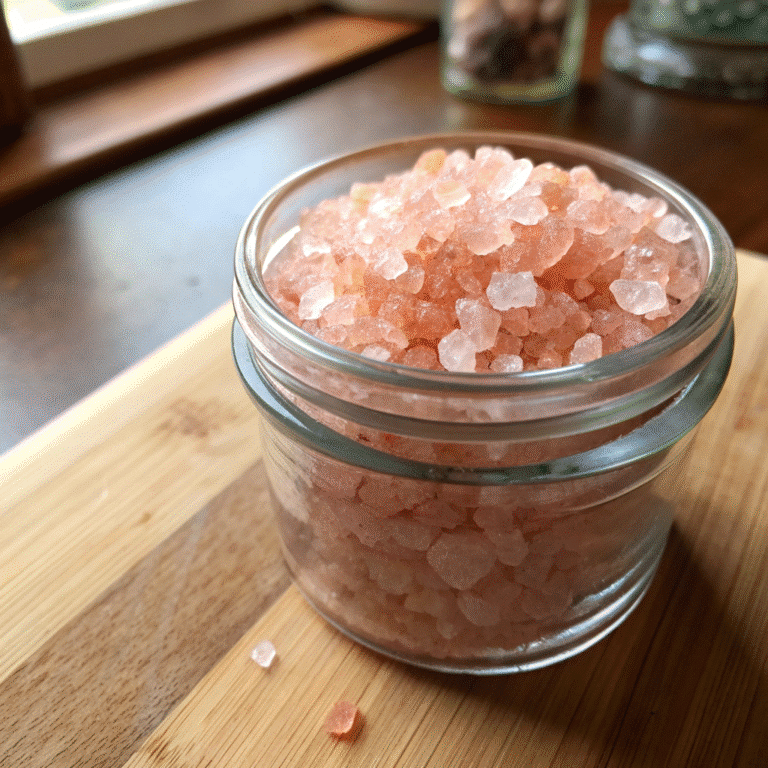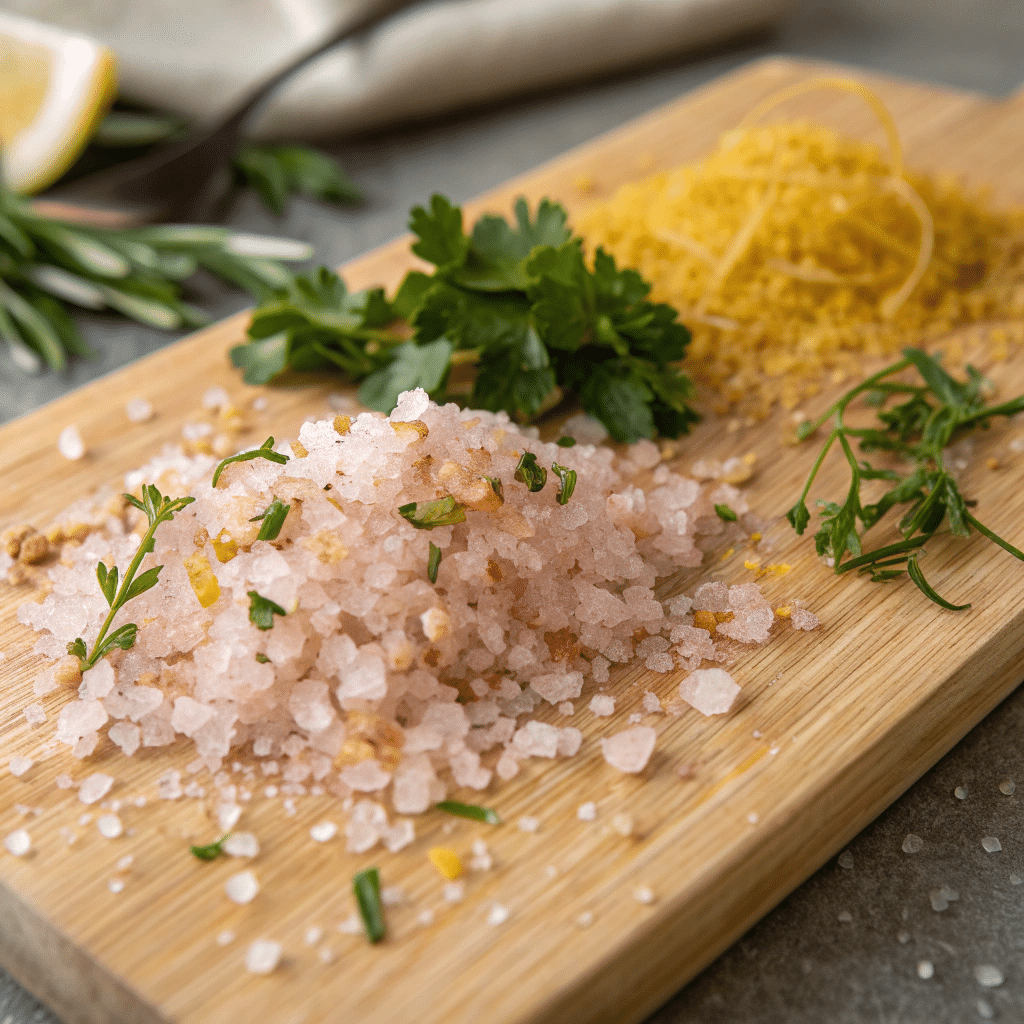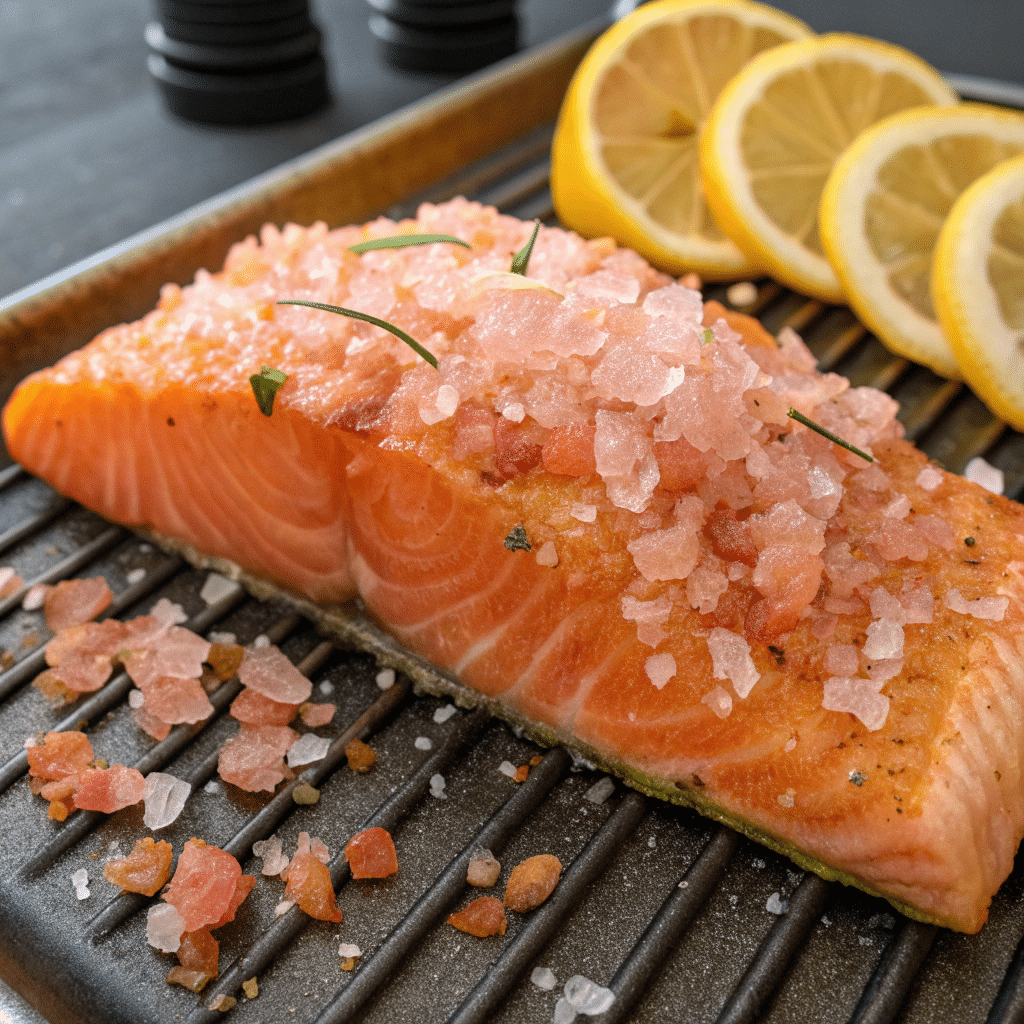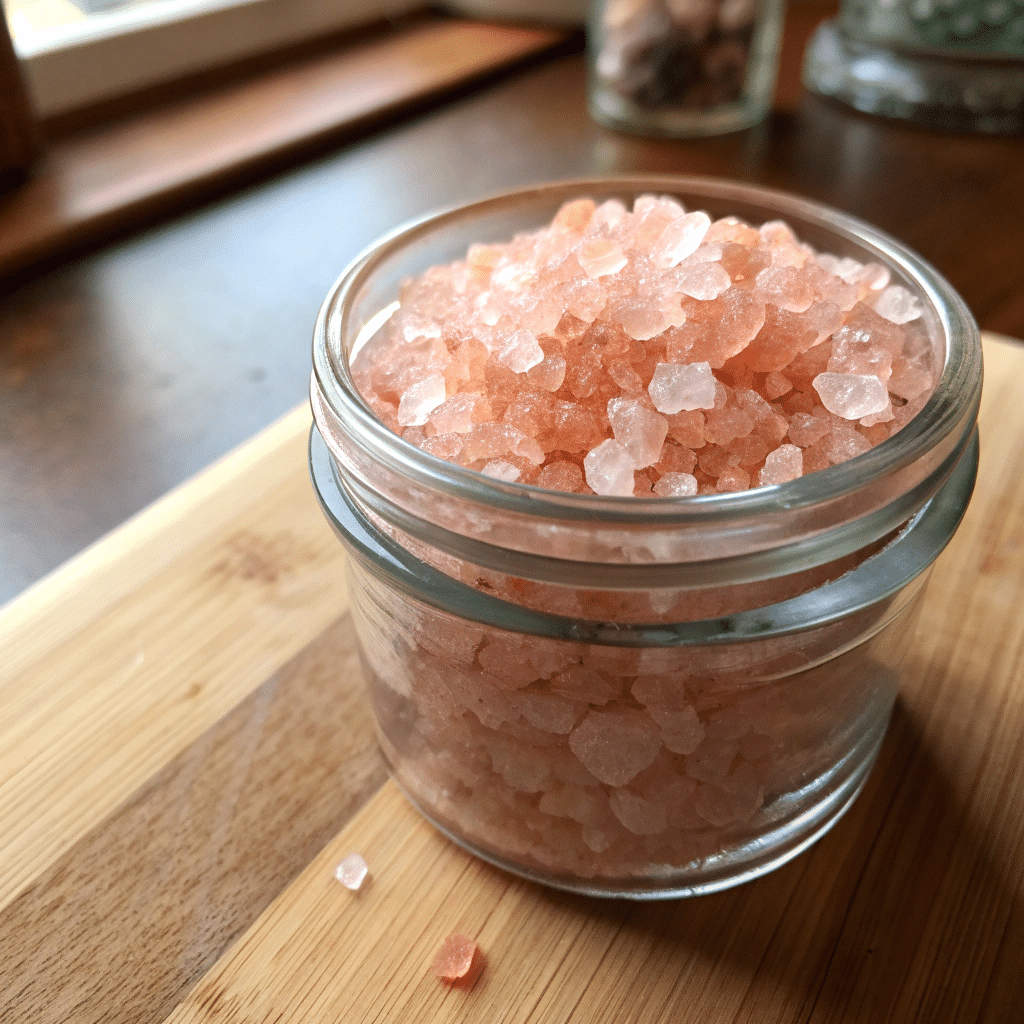Japanese cuisine is famous for its delicate balance of flavors, and one secret ingredient that has recently gained attention is Japanese Pink Salt Recipe. Known for its subtle taste and beautiful hue, this salt not only enhances the flavor of dishes but is also believed to offer several health benefits. Unlike regular table salt, Japanese Pink Salt Recipe is prized for its natural mineral content and purity. In this article, we’ll explore everything about the Japanese Pink Salt Recipe, including its history, how it compares to Himalayan salt, why it’s loved in cooking, and step-by-step instructions to make your own version at home. We’ll also answer common questions like whether you can substitute it with other salts, if it’s safe for daily use, and whether honey is an essential part of the recipe. Don’t miss our helpful tips for creating a delicious, health-boosting salt blend that can elevate your everyday meals.
Check out this clever natural remedy using ice and salt that’s also going viral for weight loss: Pink Salt Diet Recipe
Table of Contents
ToggleJapanese Pink Salt Recipe?
Origins and History of Japanese Pink Salt Recipe
Japanese Pink Salt Recipe is a naturally occurring salt with a mild, earthy flavor and a striking pink shade. Unlike the well-known Himalayan salt, which is mined from ancient rock deposits, Japanese Pink Salt Recipe is often derived from natural sea beds surrounding Japan. Its origins are deeply connected to Japanese culinary traditions, where purity and balance are emphasized in every ingredient. The pink tint usually comes from trace minerals, particularly magnesium and iron, which not only enhance the color but also contribute to its nutritional profile.
Difference Between Japanese Pink Salt Recipe and Himalayan Salt
At first glance, Japanese Pink Salt Recipe and Himalayan salt may look similar because of their color, but they are not the same. Himalayan salt is mined in Pakistan, near the Himalayan mountain range, while Japanese Pink Salt is sourced closer to Japan’s coastal regions. The mineral composition also varies: Himalayan salt tends to have more potassium and calcium, while Japanese Pink Salt contains higher amounts of magnesium and iodine, making it particularly useful in supporting thyroid health and hydration. This distinction is important when following a Japanese Pink Salt Recipe, as the flavors and health benefits differ significantly.
| Feature | Japanese Pink Salt | Himalayan Salt |
|---|---|---|
| Origin | Sea beds in Japan | Mines in Pakistan |
| Color | Light to deep pink | Pink to reddish-orange |
| Main Minerals | Magnesium, iodine, iron | Potassium, calcium, iron |
| Taste | Subtle, mild, slightly sweet | Stronger, earthy, mineral-rich |
Unique Mineral Composition and Health Benefits
The mineral composition of Japanese Pink Salt Recipe makes it a favorite among health-conscious cooks. Magnesium supports muscle relaxation and energy production, while iodine is vital for thyroid function. Unlike refined table salt, which is stripped of nutrients and often mixed with anti-caking agents, Japanese Pink Salt remains unprocessed and pure. Many people who use the Japanese Pink Salt Recipe claim that it improves digestion, balances electrolytes, and adds a natural touch of umami flavor to food. This makes it an excellent option not only for cooking but also for wellness drinks and detox recipes.
Don’t miss our Pink Salt Weight Loss Recipe for more drink inspiration that pairs perfectly with pink salt weight loss recipe detox!
Print
Japanese Pink Salt Recipe: A Complete Guide to Flavor and Wellness
5 Stars 4 Stars 3 Stars 2 Stars 1 Star
No reviews
A flavorful and mineral-rich salt blend made with Japanese Pink Salt, herbs, citrus zest, and optional honey for enhanced taste and wellness benefits.
- Total Time: 5 minutes plus drying time
- Yield: 1 cup 1x
Ingredients
1 cup Japanese Pink Salt (fine or coarse grind)
1 teaspoon raw honey (optional)
1 teaspoon dried herbs (rosemary, thyme, or shiso)
Zest of 1 organic lemon or yuzu
1 small piece of dried kelp (optional)
Instructions
1. Place Japanese Pink Salt in a clean glass bowl.
2. Add raw honey, dried herbs, and lemon or yuzu zest.
3. If using dried kelp, grind into fine flakes and add to the mix.
4. Use a wooden spoon to mix thoroughly, ensuring even distribution.
5. Spread mixture on parchment paper to air dry for several hours.
6. Optionally, toast lightly in oven at 150°F to speed up drying.
7. Transfer dried mixture into an airtight glass jar for storage.
8. Store in a cool, dry place. Use as seasoning or in wellness drinks.
Notes
Omit honey for a savory-only version.
Use freshly dried herbs for better aroma.
Adjust citrus zest to balance brightness without overpowering.
For extra variation, try matcha powder, sesame seeds, or dried ginger.
Grind salt for a fine texture or leave coarse for crunch.
Great as a finishing salt or in hydration drinks.
- Author: Jessica Lupone!
- Prep Time: 5 minutes
- Cook Time: 0 minutes
- Category: Condiment
- Method: No-Cook
- Cuisine: Japanese
Nutrition
- Serving Size: 1 teaspoon
- Calories: 0
- Sugar: 0
- Sodium: 380
- Fat: 0
- Saturated Fat: 0
- Unsaturated Fat: 0
- Trans Fat: 0
- Carbohydrates: 0
- Fiber: 0
- Protein: 0
- Cholesterol: 0
Why Choose Japanese Pink Salt Recipe in Cooking?
Enhancing Flavor and Aroma in Traditional Japanese Dishes
One of the main reasons cooks turn to Japanese Pink Salt Recipe is for its ability to naturally enhance flavors. Unlike regular table salt, which often overpowers a dish, Japanese Pink Salt adds a delicate layer of taste that elevates soups, broths, grilled fish, and even sushi rice. In Japanese cuisine, balance is key, and this salt’s mild profile blends seamlessly without masking other ingredients. Many chefs say it provides a subtle aroma and a touch of umami, making it perfect for dishes where precision matters.
Nutritional Benefits Compared to Table Salt
Standard table salt is heavily processed and often fortified with additives, while Japanese Pink Salt Recipe is naturally rich in minerals. These minerals not only improve the flavor but also contribute to overall health. For instance, magnesium helps regulate blood pressure, iron boosts energy levels, and iodine supports thyroid function. When included in a Japanese Pink Salt Recipe, these natural nutrients make it a smarter choice compared to conventional salt. Plus, the trace elements in Japanese Pink Salt Recipe give it a gentler taste, so you can use less of it while still enjoying the same—or even better—flavor.
Everyday Culinary Uses for Japanese Pink Salt Recipe
The versatility of Japanese Pink Salt Recipe is another reason why it’s gaining popularity in home kitchens. You can sprinkle it on grilled vegetables, mix it into salad dressings, or use it as a finishing touch on meats and seafood. Some people even prefer it in baking recipes, as its mildness doesn’t overpower sweet treats. Another popular method is using Japanese Pink Salt in detox water or wellness drinks, where its mineral content helps restore hydration and balance electrolytes.
Don’t miss our guide on Burnjaro Pink Salt Trick—a relaxing, detox-friendly addition to your weight loss routine.
Step-by-Step Japanese Pink Salt Recipe
Ingredients Needed for the Japanese Pink Salt Recipe
Creating your own Japanese Pink Salt Recipe at home is simple and requires only a handful of natural ingredients. The beauty of this recipe is that you can adjust it to your personal taste and health goals. Below are the essentials:
- 1 cup Japanese Pink Salt (fine or coarse grind, depending on preference)
- 1 teaspoon raw honey (optional, for sweetness and added health benefits)
- 1 teaspoon dried herbs (such as rosemary, thyme, or shiso leaves)
- Zest of 1 organic lemon or yuzu (for a citrusy kick)
- 1 small piece of dried kelp (optional, to boost umami flavor)
These ingredients not only enhance flavor but also provide unique wellness benefits. Honey adds antibacterial properties, herbs bring antioxidants, and citrus zest offers vitamin C.
Preparation Process Explained in Detail
- Mix the base – Place your Japanese Pink Salt in a clean glass bowl.
- Add the extras – Stir in the honey, herbs, and lemon zest. If using kelp, grind it into fine flakes before mixing.
- Blend thoroughly – Use a wooden spoon to blend everything evenly, ensuring the salt absorbs the flavors.
- Drying process – Spread the mixture thinly on parchment paper and let it air dry for a few hours. If you prefer, you can lightly toast it in the oven at a low temperature (no more than 150°F) to speed things up.
- Store properly – Transfer the finished salt into an airtight glass jar. Keep it in a cool, dry place, and it should stay fresh for months.
This recipe results in a versatile flavored salt that can be used for cooking, seasoning, or even making mineral-rich drinks.
Best Tips for Enhancing Flavor and Texture
- Adjust the honey: If you prefer a purely savory salt, skip the honey. If you like a slightly sweet balance, keep it in.
- Choose fresh herbs: While dried herbs work best for storage, using freshly dried herbs from your kitchen garden ensures stronger aroma.
- Balance the citrus: Lemon or yuzu zest brings brightness, but too much can overpower the salt. A teaspoon is usually enough.
- Experiment with blends: Try adding matcha powder, sesame seeds, or dried ginger for creative variations of the Japanese Pink Salt Recipe.
- Texture matters: If you like a finer finishing salt, grind the mixture slightly before storing. For a crunchy topping, leave it coarse.
Discover great ideas like Pink Salt Trick for Weight Loss if you’re looking to balance indulgence with smart nutrition.

Variations of Japanese Pink Salt Recipes
Adding Honey and Herbs for Extra Health Benefits
One of the most popular ways to customize the Japanese Pink Salt Recipe is by blending it with honey and herbs. Honey adds natural sweetness and antibacterial properties, while herbs such as rosemary, thyme, or shiso leaves provide antioxidants and refreshing aromas. This variation works beautifully for seasoning roasted vegetables or grilled meats. For a balanced flavor, keep the honey subtle so it doesn’t overpower the salt’s natural taste.
Japanese Pink Salt Recipe with Citrus Flavors
Citrus-infused Japanese Pink Salt Recipe is another exciting twist. By mixing in lemon, lime, or yuzu zest, you can create a salt that pairs perfectly with seafood and salads. The bright, tangy notes cut through rich flavors, making dishes taste lighter and fresher. If you enjoy sushi or sashimi at home, a sprinkle of citrus-infused Japanese Pink Salt can enhance the experience without needing soy sauce.
Infused Japanese Pink Salt Recipe for Gourmet Cooking
For a more sophisticated touch, try creating infused versions of Japanese Pink Salt Recipe. Adding ingredients such as dried kelp, matcha powder, or even crushed sesame seeds can create a truly unique seasoning. These gourmet blends are excellent for finishing dishes, serving as a table salt, or gifting to food lovers. Infused salts also provide additional nutrients depending on the ingredient used—for example, kelp boosts iodine, and sesame seeds add healthy fats.
Discover great ideas like the Pink Salt Trick Recipe to compare how other natural salt-based recipes are benefiting different body types and health goals.

Health Benefits and Precautions
Role of Japanese Pink Salt Recipe in Hydration and Digestion
Japanese Pink Salt Recipe is not just about flavor—it plays a role in supporting overall wellness. When mixed with water, it helps restore electrolyte balance, making it useful for hydration after exercise or during hot weather. Its natural minerals, such as magnesium and iodine, can also aid digestion by stimulating the production of digestive enzymes. Some people drink a mild solution made with this salt in the morning to support metabolism and gut health.
Can You Drink Japanese Pink Salt Recipe Water Daily?
One of the most common questions is whether drinking salt water made with Japanese Pink Salt Recipe is safe on a daily basis. The answer depends on moderation. A small amount, such as half a teaspoon dissolved in a glass of warm water, can help with hydration and detoxification. However, drinking large quantities regularly may raise sodium intake beyond healthy limits, which can affect blood pressure. If you plan to drink it daily, it’s best to keep the amount minimal and consult with a healthcare professional, especially if you have existing health conditions.
Possible Side Effects and Safe Consumption Guidelines
While Japanese Pink Salt Recipe is considered healthier than refined table salt, it’s still sodium, and overconsumption can lead to health issues. Too much salt—no matter the type—can contribute to high blood pressure, fluid retention, and kidney strain. Here are a few safe consumption tips:
- Stick to small amounts: The general daily limit for salt is about 2,300 mg of sodium, which equals roughly one teaspoon.
- Use it as a finishing salt: Adding it at the end of cooking enhances flavor without needing large amounts.
- Avoid overuse in drinks: Keep wellness drinks light, using no more than half a teaspoon per serving.
- Balance with hydration: Drink enough plain water throughout the day to support kidney function.

Substitutes and Alternatives
Can You Use Other Salts Instead of Japanese Pink Salt Recipe ?
If you can’t find Japanese Pink Salt Recipe, don’t worry—other salts can step in without ruining your recipe. While the flavor may not be identical, options like sea salt, rock salt, or even Himalayan salt can serve as replacements. The key is to choose natural, minimally processed salts that still contain trace minerals. These alternatives may slightly change the taste, but they’ll still enhance your dishes without relying on refined table salt.
Comparison with Sea Salt, Rock Salt, and Himalayan Salt
Each salt variety offers its own flavor profile and health benefits. Understanding the differences will help you decide which works best when Japanese Pink Salt isn’t available.
| Salt Type | Flavor Profile | Nutritional Value | Best Uses |
|---|---|---|---|
| Japanese Pink Salt | Mild, slightly sweet | High in magnesium, iodine, iron | Traditional Japanese dishes, wellness drinks |
| Himalayan Salt | Earthy, mineral-rich | High in potassium and calcium | Grilled meats, finishing salt |
| Sea Salt | Briny, clean | Moderate mineral content | Everyday cooking, baking |
| Rock Salt | Strong, salty | Lower mineral variety | Pickling, traditional recipes |
As you can see, Himalayan salt is the closest in appearance, but Japanese Pink Salt’s unique magnesium and iodine levels set it apart. Sea salt is a widely available option for daily use, while rock salt works best for preservation and specialty cooking.
Budget-Friendly Options Without Losing Flavor
Japanese Pink Salt Recipe can sometimes be pricey or hard to find, so choosing a budget-friendly alternative is a practical solution. Sea salt, in particular, offers a clean taste and is often available in bulk at affordable prices. You can even enhance regular sea salt by blending it with citrus zest, herbs, or kelp to mimic the flavors of a Japanese Pink Salt Recipe. Another option is mixing a small amount of Japanese Pink Salt Recipe with a larger batch of sea salt to stretch its use while still enjoying its health benefits.
Conclusion
The Japanese Pink Salt Recipe is more than just a seasoning—it’s a blend of tradition, nutrition, and flavor. With its delicate mineral profile and subtle taste, it adds depth to Japanese dishes and can even support hydration and digestion when used wisely. Whether you enjoy it plain, infused with herbs and citrus, or as part of a wellness drink, this salt offers versatility for both cooking and health. While it’s not the same as Himalayan salt, its unique benefits make it worth exploring in your kitchen.
If Japanese Pink Salt is hard to find, don’t hesitate to try substitutes like sea salt or Himalayan salt. You can even create your own blends by adding honey, citrus zest, or kelp for a gourmet twist. Most importantly, remember that moderation is key—enjoy the health benefits while keeping sodium intake balanced.
For more recipes Follow me in our Social media
Facebook: https://www.facebook.com/profile.php?id=61573913076847
Pinterest: https://www.pinterest.com/momandgrandmacooks/
Medium: https://medium.com/@momandgrandmacooks
FAQs About Japanese Pink Salt Recipe
Is Japanese Pink Salt the same as Himalayan salt?
No, they are not the same. While both have a pink color, Japanese Pink Salt comes from sea beds around Japan, while Himalayan salt is mined in Pakistan. Their mineral composition also differs—Himalayan salt contains more potassium and calcium, while Japanese Pink Salt is richer in magnesium and iodine.
Can I use another kind of salt?
Yes, you can substitute other natural salts like sea salt, rock salt, or Himalayan salt in your recipes. However, the flavor and mineral benefits will vary. If you want to replicate the delicate taste of the Japanese Pink Salt Recipe, sea salt with added herbs or citrus zest can be a great option.
Is this safe to drink daily?
Drinking Japanese Pink Salt water daily can be safe in small amounts. For most people, half a teaspoon dissolved in a glass of warm water is fine. Still, moderation is essential, as too much salt can increase blood pressure. If you have health concerns, it’s best to consult a doctor before making it a daily habit.
Can I skip the honey?
Absolutely. Honey is optional in the Japanese Pink Salt Recipe. It adds sweetness and antibacterial benefits, but if you prefer a purely savory blend, you can leave it out. Herbs, citrus zest, and kelp can still create a flavorful and nutrient-rich salt mix.








